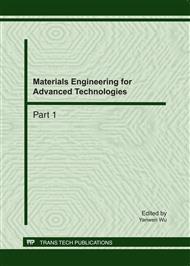p.381
p.387
p.393
p.397
p.402
p.406
p.410
p.415
p.421
Phases and Thermoelectric Properties of Bulk CoSb3 Prepared by Wet Milling and Sintering
Abstract:
For investigating the effect of wet milling time on thermoelectric properties, bulk CoSb3 was prepared via wet milling and sintering. The phases of samples were analyzed by X-ray diffraction and their thermoelectric properties were tested by electric constant instrument and laser thermal constant instrument. Experimental results show that, the major phases of the samples sintered from the powders wet-milled 2 and 6 hours are CoSb3 while the samples sintered from powders wet-milled 12 and 20 hours have more impurity phases under the experimental conditions in this work. The electric resistivities of the samples sintered from the powders wet-milled 2 and 6 hours increase with rising temperature, which show the characteristic of typical semiconductor electricity and P-type conducting due to the positive Seebeck coefficients. However, the samples sintered from powders wet-milled 12 and 20 hours show N-type conducting due to their negative Seebeck coefficients. The ZT values of the samples sintered from the powders wet-milled 2 and 6 hours are relatively higher than other samples, which increases with the temperature rising at 100~400 °C, the highest value is 0.078.
Info:
Periodical:
Pages:
402-405
Citation:
Online since:
June 2011
Authors:
Keywords:
Price:
Сopyright:
© 2011 Trans Tech Publications Ltd. All Rights Reserved
Share:
Citation:


